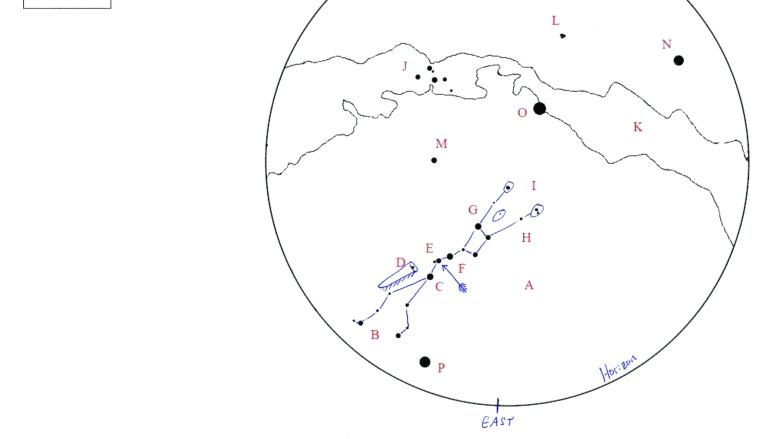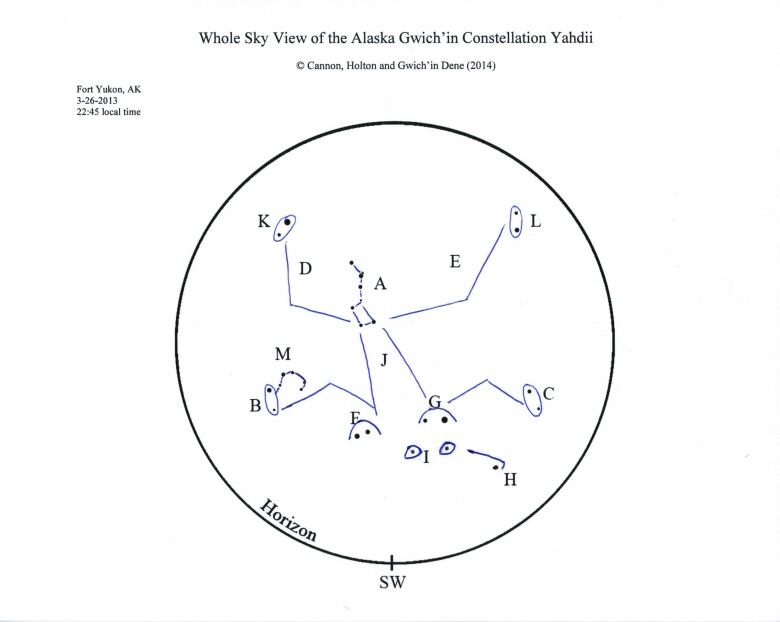Alaskan researcher documents 100 Northern Dene star names
Yellowknives Dene elders talk about a man shot in the back with an arrow, which incorporates the big dipper

A new, culturally rich picture is emerging on how Northern Dene view the night sky, according to a University of Alaska PhD student documenting the oral history of astronomy in Alaska and the N.W.T.
Cultural anthropology student Chris Cannon has been recording Alaskan Dene names for stars and constellations since 2009, and most recently has worked with the Yellowknives Dene in the Northwest Territories.
Cannon and his team of linguists and Dene consultants recorded about 100 previously undocumented Northern Dene star names and other astronomical and traditional knowledge that facilitated Dene life in the Arctic and subarctic.
"It's often claimed to be poorly developed," he says.
"The plot thickens when you start working on it."
Cannon interviewed elders from seven different Dene language groups in Alaska. When he started,only a handful of traditional names for stars, such as the ones known in Greek/Western astronomy as the big dipper and morning star, were documented in Athabascan dictionaries. But for many Northern Dene, the big dipper is only part of a much larger constellation depicting a man hunched over the Earth.

"When you look up at him, you are actually looking at the underside of his belly in this crouched position and he walks around the sky as the stars move," Cannon said.
In Alaskan Gwich'in the man is called "yahdii," an animal-like "tailed man" that spans more than 130 degrees across the sky from nose to foot. The whole-sky constellation contains 18 different star groups, or asterisms, named after body parts. The Milky Way is referred to as "yahdii's trail."
For Cannon some of the most exciting interviews were conducted recently in the Yellowknives Dene communities of Ndilo and Dettah in the N.W.T.
"Even the most viable Dene languages (in Alaska)have less than 400 speakers and so coming to the Yellowknife area where there's way more speakers, there's a larger pool of people that still have traditional knowledge,"Cannon said.
Both Ndilo and Dettah elders identified in detail a smaller man-like constellation called "yehdaa." As the story goes, the man was shot in the back with an arrow for stealing rabbit snares. In Ndilo, one elder described the man as headless, with the big dipper as his right arm. In Dettah, elders described the man with his arms thrown in the air.
"It's very exciting to find something where there was really no information before and see that it's widespread across presumably the entire northern Dene family and traits of that was carried down to the Navajo."

'It could have been lost'
Equally thrilling for Cannon was almost all of the eight Yellowknives elders interviewed had knowledge of the stars, including 58-year-old Fred Sangris, who learned to read the night sky from his grandfather and honed his skills while trapping on the barrenlands for nine years near Lac de Gras.
"As the old people say, (the man in the sky) has been there forever, and you can't hide nothing from this man: this man sees everything. The Dene laws were very strong because of that."
"I'm still not wearing a watch" says Sangris, who continues to use the stars when it's clear to navigate at night, tell time and estimate his arrival time.
"It's the best time. Better than Timex!"
For Cannon the project is time sensitive.
"Since I have started I can confidently say that one-quarter or even one-third of people I have worked with have already passed away."
Sangris agrees the knowledge is in peril.
"If Chris didn't come along, I feel it could have been lost. Chris brought some good memories back and he said 'You guys are lucky to have this information.' We need to re-learn our skies."
Sangris says many young people have not been exposed enough to the teachings. Cannon's recordings will stay in the community and potentially end up in a book about Northern Dene sky knowledge.












_(720p).jpg)


 OFFICIAL HD MUSIC VIDEO.jpg)
.jpg)



























































































